#googleseotools
Explore tagged Tumblr posts
Text
Free Google Tools For Bloggers
In this post I will share with you some of my favorite free Google tools for bloggers that can help out with SEO, content marketing and more...
Even if you are a new blogger you have heard about tools like Google Analytics. But what about other free Google tools for bloggers? There are plenty. In this post I’ll share with you some of my favorite Google tools that can help out with SEO, content marketing and more. Google Analytics Google Analytics shows you how your visitors found your website, what devices they were using, what pages…

View On WordPress
#analyzewebsite#freegoogletools#google#googleranking#googlerankings#googleseotools#googletools#improvegooglerank#improvegoogleranking#improvewebsite#marketingtools#seotools#toolsforblog#toolsforbloggers#toolsformarketing#toolsforseo#web#webdev#webdevelopment#website#wordpress
2 notes
·
View notes
Photo
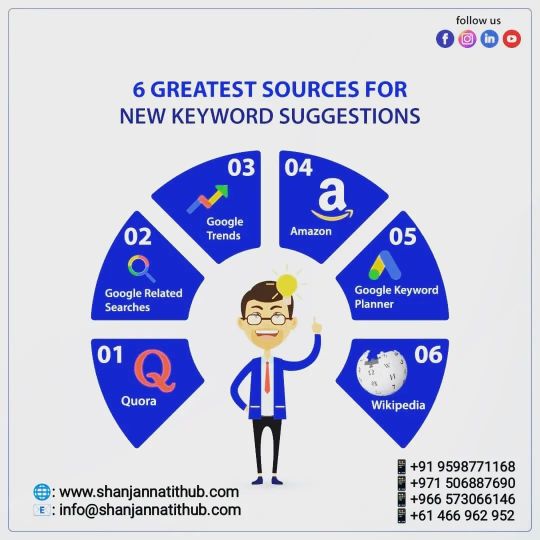
Are you struggling to find the best keywords for your business? How are you supposed to know which keywords are the best ones to target, when there is so much conflicting information online. This post will help you to find the greatest sources for new keyword suggestions. See the full infographic to know more!! For more information, please give us a call today at 📱+91 9598771168 📱+971 506887690 📱+966 573066146 📱+61 466 962 952 🌐: www.shanjannatithub.com 📧: [email protected] . . #tech #digitalmarketingagency #digitalmarketingservices #SEO #seoservices #seoadvice #seotips #seotipsandtricks #searchengineoptimization #searchengine #googleseo #googleseoservice #googleseotools #googleseoranking (at Al Rehab, Jeddah) https://www.instagram.com/p/CnL-XamLc_D/?igshid=NGJjMDIxMWI=
#tech#digitalmarketingagency#digitalmarketingservices#seo#seoservices#seoadvice#seotips#seotipsandtricks#searchengineoptimization#searchengine#googleseo#googleseoservice#googleseotools#googleseoranking
0 notes
Photo

Sometimes taking the time to wait for SEO results is important to get the best results and compare the most effective SEO methods. Visit https://quickseosolutions.com . . . . . #googlemapsseo #googleseo #googleseoservices #googleseoteam #googleseotips #googleseotools #hackers #onlinescams #phishing #phishingattack #phishingattempt #ransomware #scamming #scams #seoengoogle #seogoogle #technologynews (at London, United Kingdom) https://www.instagram.com/p/CYlwmrnMSdp/?utm_medium=tumblr
#googlemapsseo#googleseo#googleseoservices#googleseoteam#googleseotips#googleseotools#hackers#onlinescams#phishing#phishingattack#phishingattempt#ransomware#scamming#scams#seoengoogle#seogoogle#technologynews
0 notes
Link
Tools optimasi SEO menjadi salah satu alat bantu untuk mengoptimalkan kinerja Search Engine Optimization. Di mana mendapatkan kesempatan menjadi ranking 1, Penulis harus mampu mengoptimalkannya dengan berbagai ketentuan berlaku.
Salah satunya adalah keyword, poin penting hukumnya adalah wajib. Sebenarnya, untuk mendapatkan kata kunci tersebut cukup mudah. Hanya saja, tidak tahu bagaimana kinerjanya saat publish, inilah alasannya harus memakai tools.
Semakin berkembangnya artikel dan website membuat beberapa pengusaha dan para pakar membuat sebuah perangkat. Dengan begitu, penulis bisa melihat traffic hingga melihat kualitas kata yang sudah dipilih.
Apakah bisa membantu memberikan dampak positif pada artikel atau justru sebaliknya. Berikut ini ada beberapa pilihan alat bantu optimasi beserta ulasan singkat yang dapat dijadikan sebagai bahan pertimbangan.
0 notes
Photo

Meta Tags Analyzer | online tool to check Meta Tags of webpage
The Meta tag analyzer tool is there to give website owners an inside and out analysis of their Meta labels and pages. This kind of Meta Tag checker breaks down.
ABOUT META TAG ANALYZER TOOL
As we as a whole realize that Meta Tags are an ideal technique to outfit web files with information about your site pages. The Meta tag analyzer web tool is there to give site proprietors an all-around investigation of their Meta names and pages. This sort of Meta Tag checker separates the Meta marks just as the expressions on the page, from the photos, from the heading names, and from the necessary URLs.
Notwithstanding the way that the use of Meta data is unquestionably being referred to, separating a competitor's "depiction" and "keyword" Meta esteems is a respectable technique to find musings for key dialects and incredible copy for your site. Meta tags don't impact the general look of your page anyway it exhibits web files, the subject of your page, and furthermore the content of your page that is demonstrated when recorded in web crawlers and various search engines.

Perhaps the most ideal ways, when contrasted with different ways to deal with pull in the rush hour gridlock to your blog or webpage, is the web crawlers and that is the explanation site improvement is amazingly basic. You can improve your site by different methodologies; the most fundamental being the sorts of meta marks that you may use, especially the title, expressions, understanding, keywords, and the robots. There is particularly a lot to consider in the event that you need to acknowledge what are the best meta tags for you and that doesn't just incorporate the right number of meta keywords, the length of meta understanding is also basic. Click Here to Read More
#metaltag#metatag#seotools#seotoolsonline#freeseotools#seotools2021#seotoolslist#bestseotools#googleseotools
0 notes
Text
8 reasons why my site is not ranking on google

Is your content well optimized for SEO and still not ranking? Well, all your dreams seem like shattered when your kick start to the blogging career is not as per the expectations. But before you decide to quit blogging or feeling demotivated, you must read this valuable guide serving as a scapegoat for you. Why my site is not ranking on google? This is the question of almost 99% of the bloggers today. First of all, for every blog to rank, you need to have patience and fix the loopholes there. We urge you to have that courage to test your waters in tough times. We have listed down 8 possible reasons why my site is not ranking on google ever. Also Suggest: -Top Debug chrome extension for any Website
Reasons why my site is not ranking on google ever

Bargaining for free organic traffic is like a dream come true but check out a few of these mistakes you may be doing- 1. Short Length Articles This heading will force you to scratch your head. Find out how many articles you have which are just close to 700 words or even lesser. If your blogs don’t have detailed articles, it will find it hot to sit on the Search engine’s chair. As per our understanding and analysis, If you write at least 1500 words article, you will see some traction. Try for 2000 – 3000 words to beat the competition. One more suggestion- If you are about to start your first blog, you must not limit it to only text, experiment with adding images and videos also. 2. Including copied or Plagiarized Articles Are you copying word to word from other websites? The disaster you are doing with your blogging career. Plagiarism is a crime and of no real value. Use your creativity. Write in your own words. Of course, you can take inspiration from the competitors to write even better, but copying is something I will strongly discourage. Also, there are many plagiarism checkers to help you before publishing the content. Also read: - World most expensive Headphones 3. Using slow Web Hosting Uptime and Speed are the two most important factors for consistent blog growth. You will notice a fall in traffic when your web host is down or slow. Team cheapandbesthosting.com suggests to choose good hosting providers, visit the Web hosting Expert Opinions to reviews, and find great deals for yourself. You must also have an Innovative Domain and Blog names which is easy to remember. 4. Multiple Grammatical Mistakes Please write proper English or any language you want. Please make sure that whatever you have written is grammatically correct and there are no major mistakes at least. For all major and minor corrections, take the help of Grammarly which offers a free basic tool. Properly optimized content, all original, with no grammatical mistakes holds a higher chance of ranking. 5. Improper or No Keyword Research- Whenever we go to the battlefield, we always check the weapons possibly being used by your enemy. In blogging also, every blog competes with the other one. All are focusing on writing better content. But not all of them rank on the same Keyword. Your website’s authority matters a lot. Hence for new blogs, we advise using only low competition keywords. Use UberSuggest or Semrush for finding low competition keywords. Start writing on them and build good backlinks. 6. You don’t refresh your Blogs When was the last time you updated your content? Don’t think that writing a particular content is just a one-time activity. Successful bloggers update their content at least once in a quarter and even more. A search engine will always strive to search the latest content and information for every particular keyword being searched there. Hence we urge you to update content regularly Suggest: - How to speed up internet in mobile 7. No activity to retain loyal visitors “Once a customer, always a customer”, Nice saying, right? Yes, we all want regular customers or visitors. But for that, we need to keep them informed and updated. Today they have reached to your blog because of Google or Social media. But next time, if you have requested them to share their emails or subscribe to notifications, they will reach your blog often. Use plugins like One Signal and Mail chimp etc for this. 8. Your Blog is not Mobile responsive It is a fact that approx 98% of internet users prefer mobile to surf. This is the purpose almost every website uses Mobile responsive themes so that the article can be seen well on Tabs and Mobiles. Gone are the days when we only used Laptops or Desktops to connect to the Internet. In Wordpress, you get many free themes like OceanWP, Generate Press, Theme Isle, etc and they all are mobile responsive. Your content will not deform and will be seen easily on almost every device. Quick Recap of Learning So, we wish you all the success in your blogging career. But without ensuring all of the above 8 points in place, it is honestly hard for you to rank. You will also agree with the importance of all the above points noted by us. When our content is optimized, there is no grammatical mistake, we are always accessible with almost 99.99% uptime, focusing on low competition keywords, etc, we will rank one day. Have patience and keep reading us for more such informative articles. Author – Mrs. Sunny, Writer – Popular Blogging Guide If you have any problem related to why my site is not ranking in google comment it below. Read the full article
#8reasonswhyismycontentnotranking#8reasonsyourcontentwillnotrankonGoogle#bestseo#bestseotools#googleranking#googleseo#googleseotools#keywordrankchecker#localseo#rankchecker#reasonsyourcontentwillnotrank#reasonsyourcontentwillnotrankonGoogle#searchenginemarketing#searchengineoptimizationcompany#searchengineoptimizationseo#searchmarketing#seo#seocheck#seocompany#seomarketing#seooptimisation#seooptimization#seoranking#seoreport#seoservices#seosite#seotools#seoweb#seowebsite#websiteranking
0 notes
Text
Google Chrome Dev Summit 2019 Recap: What SEOs Need to Know

How to Make Your Content Shine on Google Search – Martin Splitt
Talk Summary In this session, Google developer advocate Martin Splitt explored the latest updates to Google search that are being used to provide better user experiences and increase website discoverability. He also shared the exciting news that the median time spent rendering JavaScript content, is actually only 5 seconds. Key Takeaways The Google user agent is going to be updated soon to reflect the new evergreen Googlebot. Rendering delays are no longer a big issue that we have to deal with. We shouldn’t worry about SEO implications when using JavaScript on our websites. Lazy loading, web components and Google’s testing tools are now all supported by and using the new rendering engine. What Google has done to make search better The new evergreen Googlebot One of the biggest developments to Google search this year was the announcement of the new evergreen Googlebot at Google I/O earlier this year. This was a quantum leap for Google search, from their old rendering engine that used Chrome 41 to being able to keep up with modern JavaScript heavy websites. This update allows Google to be able to render the new features Google are bringing to the web platform, in order to index the content that relies on these new technologies. After every new stable release that comes to Google Chrome, Googlebot will also be updated, so that what is seen in Chrome is reflected accurately in Google search. The testing tools, such as the Rich Results test, Mobile Friendly test and GSC’s URL Inspection tool are also now up to date with the new rendering engine. All of this means that Google search is now a lot more powerful, because it is able to render pages using the most up to date browser, to ensure what is seen and indexed by Google is the same as what is built. However, one area Google is still working on is the user agent that is seen in server logs when they are accessing content.

Martin explained that as Google is working towards maximising the compatibility between Google search and websites, it is imperative they carefully test things rather than just make quick changes. Therefore, they have had to be careful when moving forward with the user agent. The exciting news is that this is now expected to be updated in December. If you have workarounds for Googlebot, it is now important not to match to the exact user agent string, rather match roughly with Googlebot to ensure there are no issues going forward, as updates occur.

JavaScript Rendering Last year, Martin spoke at the Chrome Dev Summit about how JavaScript can be slower to render and index for Google, and can sometimes take up to a week before it is complete. This year Martin announced a massive update to this. After going over the numbers Google found that, at median, the time spent between crawling and having the rendered results is actually only 5 seconds.

This means we no longer have to worry about week-long delays for rendering JavaScript content. However, Martin explained that we should be prepared to still hear that it could take up to a week, due to the way the entire pipeline works. The pipeline that Googlebot runs through is a lot more complicated than we may think. This is due to several things happening at once, with the possibility of the same step being run multiple times. However, this isn’t something we should be worried about as certain things may happen on Google’s side whilst they crawl, render and index the content, but this doesn’t mean that it was JavaScript content that held them back.

There is a lot happening between the two points that we can actually see and measure, Google handles the processes in the middle so that we don’t have to worry about them. What we can do to ensure content is rendered faster? Google is continually working on improving their rendering by testing and monitoring what happens in search, to make sure that websites are rendered properly. Some steps we can take, together with our developers, include making sure our websites are fast and reliable and ensuring they are not using too many CPU resources. Helpful Patterns for rendering and indexing Lazy-loading The native lazy loading APIs for images and iframes are now supported in the evergreen Googlebot, this means that these attributes are not hurting a website from an SEO perspective.

Web Components Web components, including Shadow DOMs, are also now supported by Googlebot and can be indexed in Google search.

Images in Google Search Image search is a great place for users to discover content and images can be easily indexed in Google, as long as the HTML image element is used.
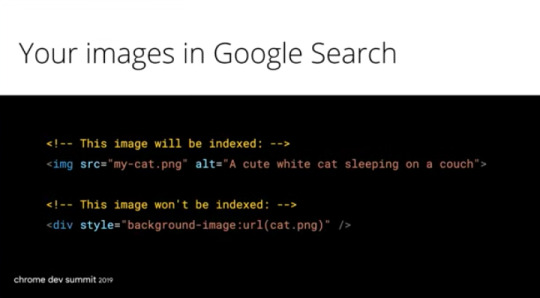
Updates to image search Google is also working towards making image search more useful for users, through better query understanding and by figuring out the context of images. Martin announced that there will be an update coming soon to GSC where webmasters will be able to inform Google, using structured data, that there is a higher resolution version of an image that can be used in image search. This will ensure there is no impact on the performance of your website. Structured data The new structured data types introduced this year included FAQ and How-to markup, which help to make it easier for Google to highlight your website within search results and on voice assistants. Updates to testing tools All of Google’s testing tools are now up to date with the Googlebot rendering engine so there are no discrepancies between the results from testing tools and what is seen by Google. This means tools such as the Mobile Friendly Test, the Rich Results Test and the URL Inspection Tool are using the actual rendering process Googlebot uses and they will continue to update as Googlebot updates. Developers and SEOs Martin concluded his session by talking about something we at DeepCrawl are also very passionate about, Developers and SEOs working together to achieve common goals. By working together, SEOs and developers can become very powerful allies by helping each other with different objectives and prioritisation. This will lead to better content discoverability and generate more traffic to our websites.
Speed Tooling Evolutions: 2019 and Beyond – Paul Irish and Elizabeth Sweeny
Talk Summary Paul Irish and Elizabeth Sweeny from the Google Chrome Web Platform showcased a 15 part blueprint that they created to effectively assess and optimise site performance at Google I/O earlier this year. This talk was a follow on from that, where they dove deeper into optimizing for a users’ experience and using Lighthouse to monitor, diagnose and fix problems. They also explained how a performance score is measured and shared the latest metrics and features available within Lighthouse. Key Takeaways Make sure you are benchmarking with the new metrics which are now available, as these will form the future of Lighthouse scoring. Take advantage of the extensibility of Lighthouse with the Stackpacks and Plugin options. Be mindful of the changes being introduced to Lighthouse and the performance score, which are due to be released early next year. Measuring the quality of a users experience There are two different elements to measuring the performance of a webpage. On one hand there is lab data, which is synthetically collected in a reproducible testing environment and is crucial for tracking down bugs and diagnosing issues before a user sees them. On the other hand, field data allows you to understand what real-world users are actually experiencing on your site. Typically, these are conditions that are impossible to simulate in the lab as there are so many permutations of things including devices, networks and cache conditions.

These metrics are most powerful when they are used together and combined. Tools including Lighthouse, PageSpeed Insights and Search Console allow for monitoring both lab and field data. Without having a clear way to accurately measure the nuances of users experience, it is difficult to quantify the impact that they have on your bottom line or be able to track improvements or regressions. This is why we need to have metrics that evolve, as our understanding and ability to measure a user’s experience also develops. Current performance metrics The metrics currently being used across lab and field data are to capture the load and interactivity of a page, but Google have identified there are gaps with these and opportunities to represent a user’s experience more accurately and comprehensively. For example, metrics such as DOM Content Loaded or Onload measure very technical aspects of a page and don’t necessarily correlate to what a user actually experiences.
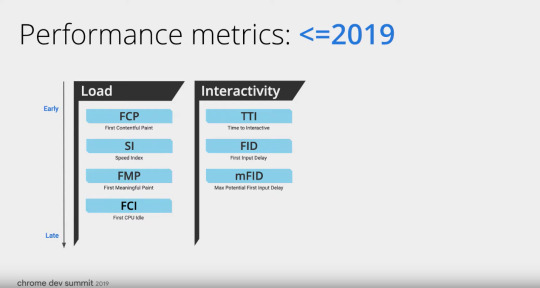
Performance metrics going forwards Moving forwards, Google is looking to fill in as many gaps in the measurement of user experience as possible. This includes some significant shifts to current metrics including a reduced emphasis on First Meaningful Paint and First CPU Idle. Instead, there are new metrics being introduced which are able to capture when a page feels usable. These metrics are; Largest Contentful Paint, Total Blocking Time and Cumulative Layout Shift. They are being used to fill in some of the measurement gaps, while complement existing metrics and provide balance. For example, while Time To Interactive does a good job of identifying when the main thread calms down later in the load, Total Blocking Time aims to quantify how strained the main thread is throughout the load.
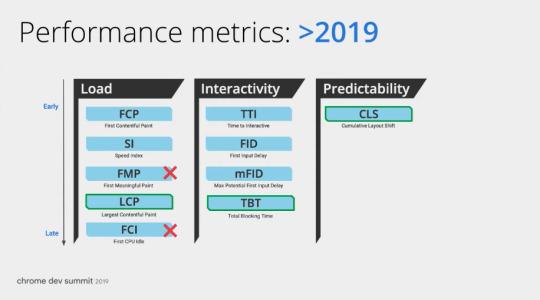
Largest Contentful Paint (LCP) aims to measure when the main, largest piece of content is visible for the user. It catches the beginning of a loading experience by measuring how quickly a user is able to see the main element that they expect and want on a page.

Cumulative Layout Shift (CLS) measures the predictability aspect of a user experience, in addition to load and interactivity metrics. Essentially CLS measures the amount that elements move around during load. For example, just a few pixels moving can be the difference between a user’s happiness, and complete mayhem of accidental clicks or images shifting on a page while it loads. Total Blocking Time (TBT) is used to quantify the risk in long tasks. It does this by measuring the impact of a long task with potential input delay, such as a JavaScript task that is loading an element on a page, for a users interaction on a website. Essentially, it is the sum of “blocking time” between First Contentful Paint (FCP) and Time To Interactive (TTI).
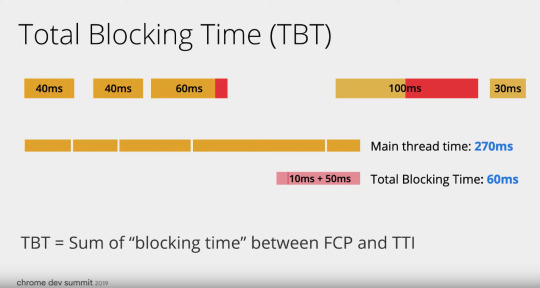
You can find out more about all the metrics used in Lighthouse and how you can measure them, on their dedicated landing page. How the Lighthouse score is calculated The current Lighthouse Performance Score is made up of 5 key metrics that are weighted and blended together to form the 0 - 100 performance score that is populated at the top of the report.

However, this score is going to be updated soon, as Google work to ensure the scoring curves and metrics are reflective of future advancements. This update will be replacing First CPU Idle and First Meaningful Paint with Largest Contentful Paint and Total Blocking Time.
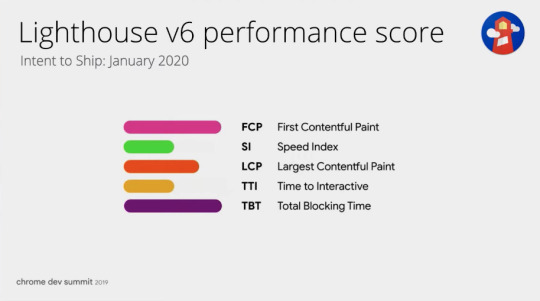
The update isn’t just used to reflect the new LCP and TBT metrics, they are also adjusting the weights to be more balanced between phases of load as well as interactivity measurement. Updates to Page Speed Insights In order to measure a user's experience as accurately as possible, Google has also added a re-analyze prompt to PageSpeed insights for sites which have been redirected to a new URL. This will display a prompt for webmasters to re-run the report for the new URL in order to get the full story of the page, from the redirect to the new page and gain trend insights.

Extending Lighthouse There are two ways you can build on top of Lighthouse in order to leverage it for your own use cases, depending on what your goals are. Stack Packs These allow for stack specific advice to be served within the Lighthouse report itself by automatically detecting whether you are using a CMS or a framework and providing guidance specific to your stack. They take the core audits of lighthouse and layer customised recommendations on top of them, which have been curated by a community of experts. Google announced they are launching further support for frameworks including Angular, WordPress, Magento, React and AMP. Plugins Plugins are allowing the community to build their own plugin specific to what they want to achieve in order to expand from the core audits offered in Lighthouse. This could be to assess things including; security, UX and even custom metrics. Once implemented they will add a new set of checks that will be run through Lighthouse and added to the report as a whole new category. Plugins also allow for customised scoring, so you can decide how things are weighted.
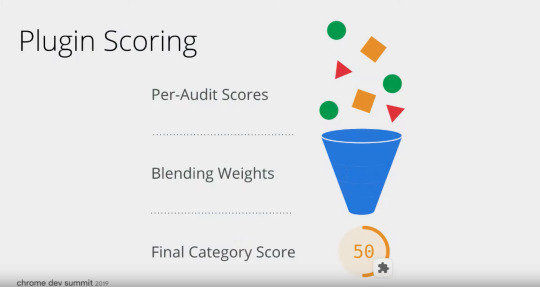
Lighthouse CI We all know how important it is to make sure that fixes to websites are viable and sustainable and be able to show this to the teams that we work with. This is why Google introduced Lighthouse CI. This will allow developers to run Lighthouse on every commit before it is pushed to production. This will allow for transparency and confidence across all teams, in order to see the potential impact of changes made.

PWA and the Installable Web – PJ Mclachlan & Sam Thorogood
Talk Summary In this session, Google’s PJ Mclachlan and Sam Thorogood explored how to ensure PWA’s are created in a way that lives up to users’ expectations and also shared some best practice recommendations for promoting web apps. Key Takeaways When creating web apps it is important to live up to users’ expectations and provide a seamless experience. Not every user is going to benefit from using a PWA, so ensure you define the best audience to promote it to. When promoting a web app on a site make sure you focus on the benefits of installing it and that you are not interrupting a user’s flow. What is web install? Web install is also known as “Add to Homescreen” and is a way to tell users that the website experience is made for their device. However, this could mean one of two things, either it’s just a bookmark that is being added to the homescreen, or it could be an actual integrated experience on the device. PWA’s allow for your website to launch from the home screen and is indistinguishable from a native experience.
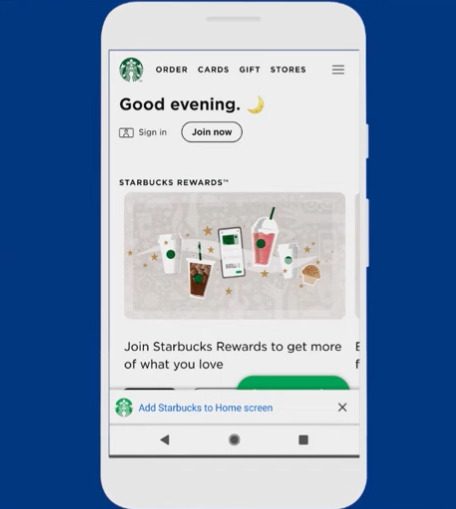
An installed web app is designed to look and feel exactly the same as every other app on a device. It shouldn’t matter to users whether they installed this from an app store, or from the browser itself. Living up to users experiences When asking users to install a web app you are telling them that it is an experience meant for the device they are using, which means that it needs to live up to their expectations. PWAs are a pattern for great apps that use web technology, as they have all the features and functionality users expect from a modern app on mobile or desktop device.

The goal of a PWA is to build directly on the web, so that only one code base needs to be maintained and will work for users both on browsers and through the installed app. Designing for specific users Not every user is going to benefit from the extra power of web apps however, so it is important to define the audience you expect to benefit the most from your PWA. This is done by using a funnel approach to define actions that signal a strong user intent. For example, you might want to only promote the install option to users who frequently visit your site. Most importantly, it’s important to focus on the the user, and why a web app is going to be beneficial for them. You will also want to track the right events in Google Analytics, in order to know what you can optimise, as well as promote web install where it makes sense for a user’s device. Acquiring more installed users There are a few things you can do in order to help acquire more installed users, this includes avoiding channel conflicts and understanding when is best to present users with the option to install. Avoid channel conflicts When promoting your PWA you want to ensure that you’re not creating any channel conflicts by promoting it to people who are currently native app users. There are a number of reasons a user might not be using your native app, but might find benefits in using your web app. The main example of this is due to storage, as native apps can take up a lot of space on a users device. Web apps on the other hand only require a small amount of storage space and the storage that most use is actually dynamically purged from the browser. Google provide the getInstalledRelatedApps API which will allow you to see in JavaScript if a user has your native app already installed. Hide the mini infobar Most PWA installs are happening from the mini info bar, however this was only intended to be temporary as it doesn’t provide the best user experience. Due to being generated by the browser, it has no way of knowing when is the best time to present users with the option to install. In order to ensure the mini info bar doesn’t appear you can add a listener for the beforeinstallprompt event and call the preventDefault( ) method.

It’s also important to implement analytics when performing the above, in order to understand your users’ behaviour with respect to install prompts. The three important events to track are: When the site is qualified for install, with the beforeinstallprompt event. When the prompt has been triggered, for example a ‘click’ event. When the app install has been successfully completed, by using the appinstalled event. UX Considerations There are several UX elements you need to consider when creating a web app, this includes; Disallowing navigation to other domains outside of your site as this can provide a bad experience for users. Instead, make sure you always open external content in a new window. Provide better behaviour for actions such as copy and paste, select all and undo or redo. Disable the right click menu in order to improve the user experience across devices. Where to promote web apps Within the header When using the header to promote web app installs it is important to use information architecture and A/B testing to determine whether it makes sense to place the install option in the header. If you are going to display it within the header, ensure it doesn’t take precedence over other critical functionality. Hamburger menu Another place useful to add the install prompt is within the hamburger menu, this is because it provides a strong signal that users are engaged with the website. However, ensure that it doesn’t add clutter to the menu or take precedence over other actions a user might want to take. Landing Page A landing page is also a great place to promote the install option, as it is a place where you are explicitly marketing your content and you can focus on informing users of the benefits that come with installing your web app. Key engagement moments Promoting the install option within the key moments of engagement in a users journey helps to encourage users to download, as they are in a place of true interest in what you are offering. The main principles for promoting PWA install Don’t be annoying, interrupt a user’s flow or make it difficult for them to complete the task they came to your website for. If the web app is not going to benefit the user, don’t promote the install option to them. Use context to help the user understand the value of installing your app. Read the full article
#chromegoogledev#googlechromedev64#googlechromedevapk#googlechromedevblog#googlechromedevbuild#googlechromedevexe#googlechromedevmode#googlechromedevsummit#googlechromedevx86#googlegooglechromedev#googleseoads#googleseoguide#googleseojobs#googleseokeyword#googleseotools#googleseoom#googleseoul#seogoogleadsexplorers.com#seogoogleownsads.com#seogooglepublicityad.com
0 notes
Photo

The success of an SEO strategy significantly relies on the SEO tools employed. Attempting to plan your upcoming SEO strategy with best in class SEO tools? Shan Jannat IT Hub Services is here to help! Call Or WhatsApp +91 9598771168 +971 506887690 +966 573066146 +61 466 962 952 [email protected] www.shanjannatithub.com . . . . . . #seo #seostrategy #seotools #freeseotools #seotoolslist #googleseotools #seoservice #seoagency #onpageseo #offpageseo #searchengineoptimization #seoexpert #seomarketing #seostrategy #digitalmarketingagency #seocompany #webdevelopment #webstagram (at Dubai, United Arab Emiratesدبي) https://www.instagram.com/p/Cdsfiu6rK5r/?igshid=NGJjMDIxMWI=
#seo#seostrategy#seotools#freeseotools#seotoolslist#googleseotools#seoservice#seoagency#onpageseo#offpageseo#searchengineoptimization#seoexpert#seomarketing#digitalmarketingagency#seocompany#webdevelopment#webstagram
0 notes